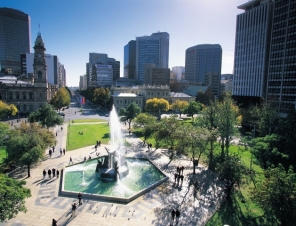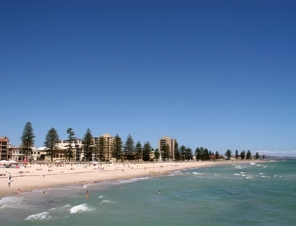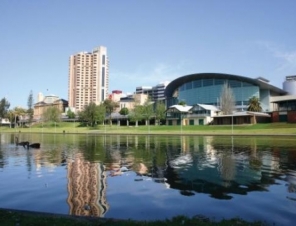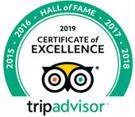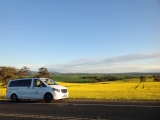
ADL-G8 | Private Small Group Winery Tour | 6.00 hrs
Book one of our small group tours suitable for 2-10 persons driven by our experienced guides. They will discuss the options with you on the day and make sure you see and do what you want, getting you back to the ship in good time. We can pre-book your activities as well.

ADL-G9 | Full Day Private Small Group Tour | 8.00 hrs
Book one of our small group tours suitable for 2-10 persons driven by our experienced guides. They will discuss the options with you on the day and make sure you see and do what you want, getting you back to the ship in good time. We can pre-book your activities as well.
There is so much to do in this vibrant city. A short train ride from the cruise ship terminal takes you into the historic Port Adelaide district, travel a little further and you are in the heart of this cosmopolitan city, set out in the mid 1800's in a regular grid format, the city bounded on all sides by open spaces and parks.
You can explore the many shopping arcades, snack at the 100's of cafes with the locals, or visit the local museums. A short drive from the city and you can be in the famous wine regions of the Barossa, McLaren Vale and the Clare Valley.
The historic town of Hahndorf in the Adelaide Hills is noted for its Germanic origins and also has a number of great wineries. Car buffs will be interested in the National Motor Museum at Birdwood. Venture further if you time to experience the raw beauty of the Outback.
Adelaide is the capital city of South Australia and the fifth-largest city in Australia, with a population of 1.23 million. Adelaide is north of the Fleurieu Peninsula, on the Adelaide Plains between the Gulf St Vincent and the low-lying Mount Lofty Ranges which surround the city. The city stretches 20 km (12 miles) from the coast to the foothills, and 90 km (56 miles) from Gawler at its northern extent to Sellicks Beach in the south.
Named in honour of Adelaide of Saxe-Meiningen, queen consort to King William IV, the city was founded in 1836 as the planned capital for a freely settled British province in Australia. Colonel William Light, one of Adelaide's founding fathers, designed the city and chose its location close to the River Torrens in the area originally inhabited by the Kaurna people. Light's design set out Adelaide in a grid layout, interspaced by wide boulevards and large public squares, and entirely surrounded by parkland. "Light's Vision", as it has been termed, has meant that the initial design of Adelaide required little modification as the settlement grew and prospered.
Early Adelaide was shaped by religious freedom and a commitment to political progressivism and civil liberties, which led to the moniker "City of Churches".
As South Australia's seat of government and commercial centre, Adelaide is the site of many governmental and financial institutions. Most of these are concentrated in the city centre along the cultural boulevard of North Terrace, King William Street and in various districts of the metropolitan area.
Today, Adelaide is noted for its many festivals and sporting events, its food, wine and culture, its long beachfronts, and its large defence and manufacturing sectors. It ranks highly in terms of liveability, being listed in the Top 10 of The Economist's World's Most Liveable Cities index in 2010, 2011 and 2012.
Prior to its proclamation as a British settlement in 1836, the area around Adelaide was inhabited by the indigenous Kaurna Aboriginal nation. South Australia was officially proclaimed as a new British colony on 28 December 1836, near The Old Gum Tree in what is now the suburb of Glenelg North. The event is commemorated in South Australia as Proclamation Day.
Adelaide was established as a planned colony of free immigrants, promising civil liberties and freedom from religious persecution, based upon the ideas of Edward Gibbon Wakefield. Wakefield had read accounts of Australian settlement while in prison in London for attempting to abduct an heiress, and realised that the eastern colonies suffered from a lack of available labour, due to the practice of giving land grants to all arrivals. Wakefield's idea was for the Government to survey and sell the land at a rate that would maintain land values high enough to be unaffordable for labourers and journeymen. Funds raised from the sale of land were to be used to bring out working class emigrants, who would have to work hard for the monied settlers to ever afford their own land. As a result of this policy, Adelaide does not share the convict settlement history of other Australian cities like Sydney, New South Wales; Brisbane, Queensland and Hobart, Tasmania.
As it was believed that in a colony of free settlers there would be little crime, no provision was made for a gaol in Colonel Light's 1837 plan. However, by mid-1837 the South Australian Register was warning of escaped convicts from New South Wales, and tenders for a temporary gaol were sought. Following a burglary, a murder, and two attempted murders in Adelaide during March 1838, Governor Hindmarsh created the South Australian Police Force (now named South Australia Police) in April 1838 under 21-year-old Henry Inman.
Adelaide has a warm Mediterranean climate where most of the rain falls in the winter months. Rainfall is unreliable, light and infrequent throughout summer. In contrast, the winter has fairly reliable rainfall with June being the wettest month of the year, averaging around 80 mm, frosts occur only occasionally. Hail is also common in winter, though snowfall in the metropolitan area is uncommon, except for very light falls at Mount Lofty and some places in the Adelaide Hills.
How long does it take to get into the city centre from the port
The Port Adelaide Passenger Terminal is on Oliver Rogers Road at Outer Harbor. Outer Harbor is a north-western suburb of Adelaide, South Australia, 22km from the Adelaide city centre. It is adjacent to Osborne, North Haven and Pelican Point. The journey will take around 30 minutes.
How can i get into the city centre.
The primary form of public transport to Outer Harbor is the Outer Harbor railway line which connects the area to the centre of the City of Adelaide. The terminus of this line is the Outer Harbor station, situated next to the North Haven Golf Course and the Port Adelaide Passenger Terminal. One bus route services the area, the 330, a loop service connecting with other bus services in neighbouring North Haven. The Outer Harbor train station is located 200 metres from the passenger terminal building – a new walkway has been created to make it easy and safe for passengers to walk with their luggage from the terminal to the train station.
What things are there to see or visit close to the port.
The National Railway Museum is close to the port. Take a journey into railway history at the National Railway Museum, Australia's largest railway museum with over 100 exhibits representing State, Commonwealth and private railway operators on the three major rail gauges used in Australia. Just 10km from the cruise terminal.
I believe that Glenelg is a great place to visit, how can i get there?
Yes, its a beach side suburb of Adelaide and you can easily get there from the city centre by tram.

 |
|





